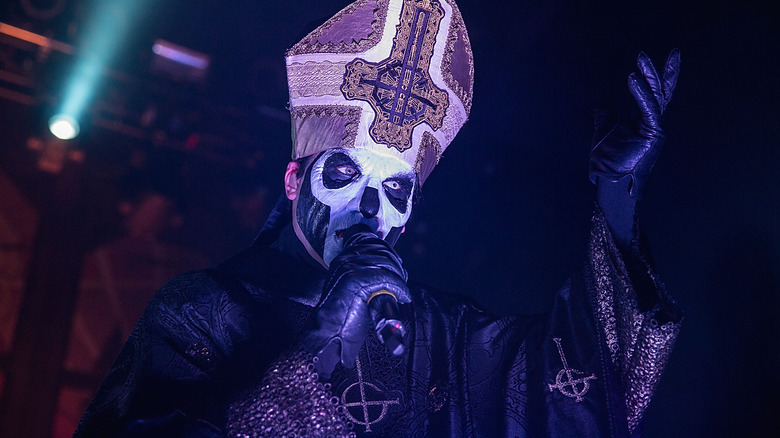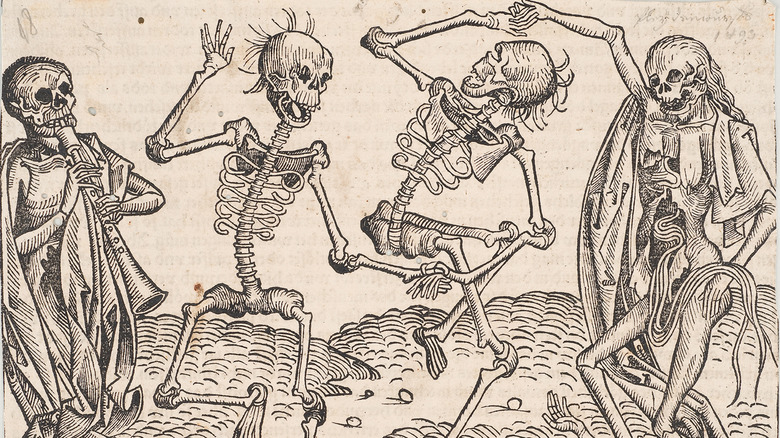How Ghost Came Up With Their Hit Song Dance Macabre
Ghost: The Abba of the metal world. Or as many metalheads would say: "metal." Musical debates about the authentic heaviness of Swedish outfit Ghost and its back-from-the-80s Satan-lite Halloween cosplay schtick aside, Ghost is an undeniable, global, cross-cultural success. Some fans chalk up their acclaim to project lead Tobias Forge's ability to, let's say, forge well-crafted melodic forays. Others just point and say, "Look, funny pope hat man wears makeup." Sure, that's true when Forge — also the lead singer — dons his full Papa Emeritus regalia and miter rather than when he played Cardinal Copa, who went with his au naturel hair and ... Okay, listen. If you want to get into Ghost, be prepared for some silliness.
Ghost's five-album, 13-year catalog contains loads of hits: "Square Hammer," "Cirice," "Rats," "Spillways," "Mary on a Cross," etc. Those hits have gotten their fair share of flak from hardcore headbangers for their easy listening value, but it's also that value that's allowed the band to reach their audience — especially with "Dance Macabre." When the song debuted on 2018's album "Prequelle," Louder called it a "pure 80s rock-club banger that's as audacious as it is glorious" and the album on a whole "shameless pop" (as a compliment). While Ghost had always waxed theatrical, Forge on Louder described "Dance Macabre" as resulting from "Prequelle's" overall ethos: A loosening of the reins and letting Ghost go "rock opera" and "more Queen than AC/DC." On Blabbermouth he also called it a "car chase."
A big, goofy, macabre party
Ultimately, "Dance Macabre" came from the same place as all the rest of Ghost's songs: Project lead Tobias Forge's songwriting philosophy. "With Ghost every song has to have its own clear idea and structure," he told Louder. And in the case of "Dance Macabre," that idea is right in the title: dance. What kind of dance? A goofy macabre one — kind of like a big party where everyone is really into dark eyeshadow. This is exactly what the music video for "Dance Macabre" shows, featuring two hapless dudes strolling up to a manor filled with black-clad goths bouncing on the dancefloor. It's this juxtaposition of appearance versus sound that's arguably helped grant Ghost its success. On appearance alone, Ghost's aesthetic might appear ferocious. But really, it's all just a hoot.
On that note, Forge talked to Louder about not limiting his music, saying, "With Ghost you can do pretty much anything." With 2018's "Prequelle" he also wanted to expand on the band's previous two albums: 2013's "Infestissumam" and 2015's "Meliora." Moreover, he wanted to make it clear that not every Ghost song "starts with a big guitar intro." On Blabbermouth he also describes how the placement of "Dance Macabre" in the album's tracklist matters, saying, "You cannot really decipher [the album] just by hearing one song." "Dance Macabre," he says, was written to suit its position in the album because he "needed a car chase" for that song's particular vignette.
The dance with death
Even though Ghost frontman Tobias Forge hasn't said so explicitly, the likely inspiration for "Dance Macabre" is one particular art style: Danse Macabre (and yes, "danse" and "dance" are homophones). As The Collector explains, European artwork in the 14th century saw the rise of a particular, repeating theme: dancing skeletons. We've got skeletons prancing around hand in hand with the well-dressed, skeletons accompanying processions of people down the street, skeletons playing musical instruments, skeletons frolicking above begging nobles — you name it. The title of that last work — 1485's "The Triumph of Death" by Giacomo Borlone — says it all: No one can escape death. And those skeletons? They seem pretty happy about the whole thing.
Such was the tenor and mood of an age of rampant death and doom. This was especially true during the Black Death (1347 to 1353 C.E.), a plague that left some towns 90% depleted of their populations and the entire globe shrunk from 500 million to 300 million, by some estimates. Take this and add to it famine, war, and generally inhospitable living conditions, and you've got a recipe for folks expressing their fears in a macabre, perhaps tongue-in-cheek way: Death dancing amongst us.
While Ghost's "Dance Macabre" might not have this exact function in mind, it does serve a similar purpose of undercutting the grim and serious. After all, if death is inevitable, why not just grab it by the hand and sweep it onto the dance floor?

